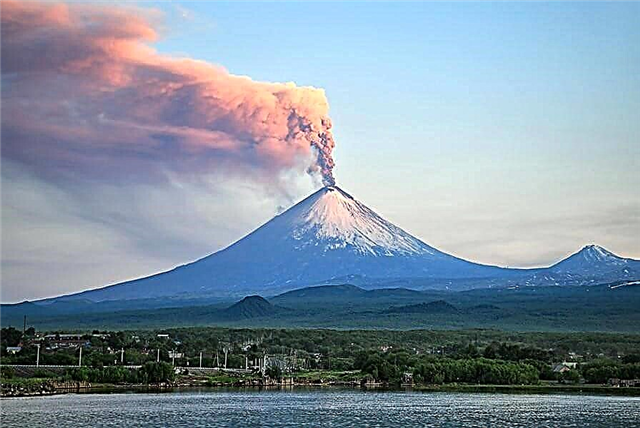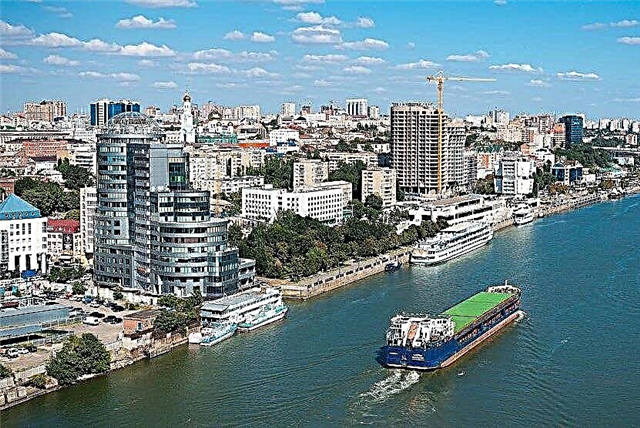The territory of the modern Rostov region was annexed to the Russian state in the 17th-18th centuries. Rostov-on-Don immediately after its foundation became a major trade center. Initially, most of the cities near it were built to defend against raids from the south. Thanks to the successful military campaigns of the Russian army, the cities soon became peaceful centers of agriculture and trade.
Today Rostov-on-Don is one of the largest cities in Russia. The Rostov region is becoming a leader in terms of the population's standard of living. Tourism is actively developing in cities, and the economy is growing rapidly. The region is distinguished by a developed infrastructure in small settlements and an increase in the population of regional centers. This is ensured by the development of agriculture and the creation of new jobs in cities.
The largest cities of the Rostov region
List of the largest cities in terms of population in the region.
Rostov-on-Don
The city was founded at the end of the 18th century and immediately became a major commercial port and defensive fortification. Today Rostov-on-Don remains a major trade center. The city is an important transport hub, economic and cultural center. A large number of theaters, museums, art galleries and other attractions are located here. The city has many memorials, most of which are dedicated to the heroes of the Great Patriotic War.
Population - 1,137,904 people (2020).

Taganrog
The first Russian naval base was founded in 1698. Due to its advantageous location on the coast, the city developed rapidly as a commercial and industrial center. Nowadays, one of the leading sectors of the Taganrog economy is metallurgy and the automotive industry. The city has a large number of art galleries, where works of various styles of painting are collected, and theaters. Creative teams from many regions of Russia regularly come to Taganrog.
Population - 250 thousand people.

Mines
One of the youngest cities in the Rostov region was founded in 1867. There are large deposits of coal in the mines, which were especially actively developed during the Soviet period. The city has a large number of children's sports and creative sections. Thanks to the quality coaching staff in these institutions, several Olympic and Paralympic champions have been trained in the city of Shakhty.
Population - 235 thousand people.

Volgodonsk
The city was founded in 1950 during the creation of the Volga-Don Canal. In the place of modern Volgodonsk, temporary settlements of workers and buildings of the project administration were located. Soon a chemical plant was built here, and in the 70s a machine-building plant was opened. Nowadays, there are many cultural institutions in Volgodonsk. A large number of sports and art schools work here, theaters and art galleries are opening.
Population - 172 thousand people.

Novocherkassk
The city was founded in 1805. The capital of the Don Cossacks was moved here due to its more convenient location. Due to the reluctance of the Cossacks to move to a new location, Novocherkassk developed slowly in the early years. The most active development of the city fell on the Soviet period. In 1962, the authorities carried out the Novocherkassk execution, more than 20 people died. Nowadays Novocherkassk remains the capital of the Cossacks. The city is home to many historical museums and other attractions.
Population - 169 thousand people.

Bataysk
The city was founded in 1769. The period of the most active development of Bataysk fell on the first half of the 20th century. Today the city is an important transport hub and industrial center. Bataysk has a large number of libraries and cultural and leisure centers. The city has many monuments and monuments. Most of them are devoted to the events of the Soviet period and the history of Bataysk.
Population - 125 thousand people.

Novoshakhtinsk
The discovery of coal seams near the modern city took place at the end of the 17th century. It gave rise to the development of the Donetsk coal basin. In 1939, 2 workers' settlements were united into modern Novoshakhtinsk. In 2003, coal mining in the city was completely stopped. Nowadays, several industrial enterprises operate in Novoshakhtinsk. Schools and kindergartens are being opened, as well as departments of colleges and institutes.
Population - 109 thousand people.

Kamensk-Shakhtinsky
One of the most ancient cities of the Rostov region was founded in 1671. Kamensk-Shakhtinsky was originally a Cossack village. The city reached its greatest development at the beginning of the 20th century thanks to the growth of the coal industry. Coal mining is still the main branch of the economy of Kamensk-Shakhtinsky. Today, there are a large number of museums, temples and galleries here. One of the most popular attractions is the Patriot military park.
Population - 90 thousand people.

Azov
The oldest city in the modern Rostov region was founded in 1067. Azov was annexed to the Russian state during the reign of Peter I. The city immediately became an important transport hub and defensive point. Nowadays, there are several large industrial enterprises in Azov. The city has a large number of monuments and memorials, houses of culture and historical museums function.
Population - 81 thousand people.

Gukovo
The city was founded in 1878 and was originally a transport hub on the railroad. Thanks to the discovery of coal deposits near Gukovo, at the end of the 19th century, the city began to develop rapidly. Today, the city's coal mining enterprises are in a state of crisis. Light industry enterprises play a leading role in the economy of Gukovo. The main attraction of the city is the Museum of Miners' Labor.
Population - 66 thousand people.

Salsk
The city was founded in 1812. After the construction of the railway, modern Salsk became an important transport hub. Industrial and agricultural products were transported through the city. Nowadays, several large enterprises are located on the territory of Salsk. Most of them are related to light and manufacturing industries. The city has a large number of monuments dedicated to the Great Patriotic War.
Population - 58 thousand people.

Donetsk
The city was founded by the Don Cossacks in 1681. The village was relocated many times due to changing natural conditions. At the end of the 19th century, Donetsk began to actively develop as a center of the coal mining industry. Coal mining is still an important branch of its economy. A large number of historical sights of the city are dedicated to the miners working in Donetsk.
Population - 46.9 thousand people.

Aksai
One of the most ancient cities of the Rostov region was founded in 1570. Modern Aksai was a Cossack village with an advantageous location at the confluence of the Don and Aksai. Today the city has a large number of monuments and historical museums. They are dedicated to the foundation of Aksai and its development. There is also a small military equipment park in the city.
Population - 45 thousand people.

Belaya Kalitva
The modern city was founded in 1703. Thanks to archaeological excavations, it was established that the first settlements on the territory of Belaya Kalitva were built several thousand years ago. The city is one of the centers of metallurgy in the Rostov region. Many monuments of the city are dedicated to its history. The Belaya Kalitva Museum of Local Lore contains a large number of historical exhibits.
Population - 41 thousand people.

Red Sulin
The city was founded in 1797, but the period of its greatest development fell only at the beginning of the 20th century. A large metallurgical plant was built, destroyed during the Great Patriotic War and rebuilt in the postwar years. The city has several monuments dedicated to the workers and heroes of the Great Patriotic War. Also in Krasny Sulin there are several temples and churches that are architectural monuments. The Don Cossacks Museum is located in the central part of the city.
Population - 38.5 thousand people.

Millerovo
The city was founded in 1786. In the second half of the 19th century, a railway was built here and Millerovo immediately became a major center for processing agricultural raw materials. Today, the city's economy is specialized in agriculture and the production of machinery. The main attraction of Millerovo is the local history museum, and Voloshinskaya Gora attracts many fans of hang gliders and paragliders.
Population - 35.5 thousand people.

Morozovsk
One of the youngest cities in the Rostov region was founded in 1910. Morozovsk was one of the villages of the Don Army. The basis of the city's economy is the transportation of industrial and agricultural products by rail. A large number of monuments in Morozovsk are dedicated to the railway and the history of Soviet power. The cultural center is located in the central part of the city.
Population - 25.5 thousand people.

Zernograd
The city was founded in 1929 to develop and implement advanced agricultural technologies. For several years, residential buildings, production facilities and institutes were built in Zernograd. Today the city remains an important center for the production of equipment and materials for agriculture. Also Zernograd is a cultural and educational center. There are several museums and a number of large institutes and technical schools in the city.
Population - 25 thousand people.

Semikarakorsk
The exact year of the founding of the ancient city has not been established, but the first mention of it dates back to 1594. Due to the Don spills, Semikarakorsk was repeatedly moved and rebuilt. Nowadays, there are several enterprises that process agricultural products. There are several historical monuments and a local history museum in the city.
Population - 22 thousand people.

Zverevo
The first settlement on the site of the modern city was built in 1819. Zverevo was a railway station, and the station, built in 1894, has survived to this day. The city's economy is based on agricultural and processing enterprises. Most of the sights are dedicated to the history of Zverevo and the workers of the coal mines located near the city.
Population - 19.5 thousand people.












